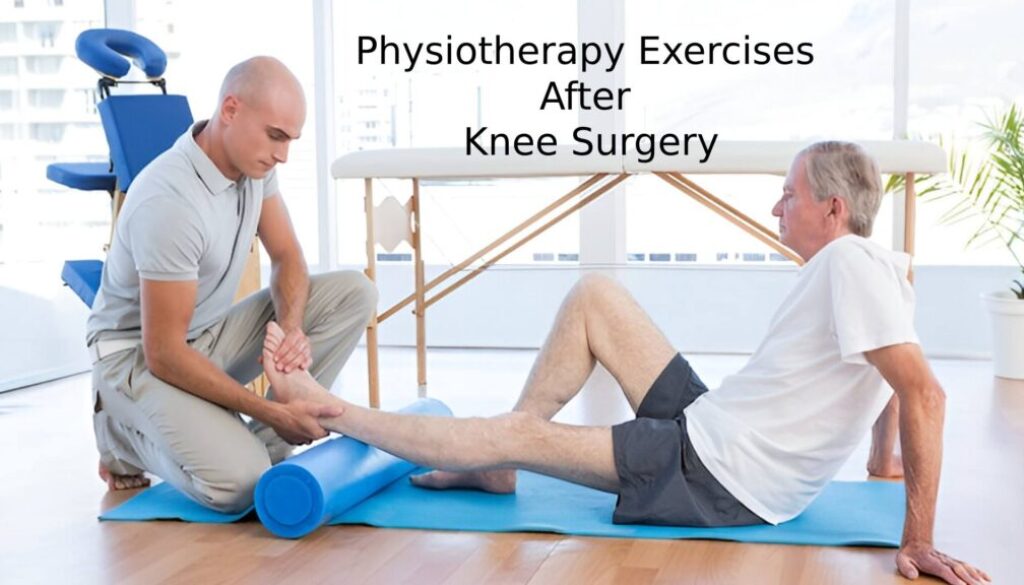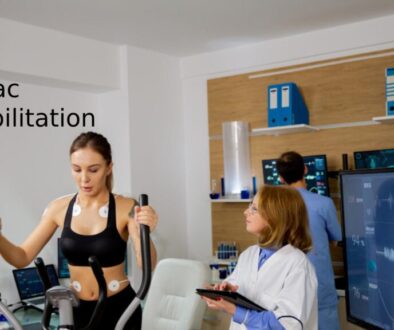Best Physiotherapy Exercises After Knee Surgery Recovery
Introduction
Exercises that can help you recover from your knee specials can be time-consuming ensure you take the few moments needed to do them. Be it Total KNEE replacement, ACL reconstruction, or MENISCUS surgery, physiotherapy is a significant treatment in restoring mobility and strength. Moreover, how vital it is to stick to a structured rehabilitation program at each stage of the healing process, including various exercises.
In this guide, we will discuss the most effective physiotherapy exercises for knee surgery recovery, when to begin them and the contribution that physiotherapy makes in restoring the knee to normal function.
Physiotherapy after knee surgery – Why Poses Great Benefits?
Physiotherapy is not just movement, it’s healing in the right way. Below are some major gains of post- surgical workout:
Increased mobility and flexibility: Routine physiotherapy keeps knee stiffness at bay and promotes motion range.
Decreases pain and decrease: Gentle movement promotes blood flow, helping to prevent swelling.
Avoids complications: Blood clots are a common risk of surgery so circulating limbs helps to avoid these.
Strengthens muscles: Muscle strengthening around the knee joint gives better support and decreases stress on the joint.
Automated Behavioral Recovery: Following a well-structured exercise regimen facilitates faster recovery to routine tasks.
Guidelines/Precautions for Post-operative Exercises
Before we get into the exercises, let’s go over some basics:
Take it easy: Start with gentle movements first and work your way up.
Pay attention to your body: Some discomfort is normal, sharp pain means back off.
Establish a routine: A routine is important for recovery.
Use support as needed: In the beginning, you may require assistance like crutches or a walker.
Ask your doctor: Always consult your surgeon or physiotherapist before introducing new exercises.
Phase 1: Initial Recovery (0-2 Weeks After Surgery)
During the first two weeks post-op, they work on preventing stiffness, minimizing swelling and waking up muscles. The purpose is to wake things up without having the knee do too much work.
Recommended Exercises:
Ankle Pumps
Lie on your back with your legs extended.
Flex and point your foot, working through your calf muscles.
Do for 10-15 each session.
Quadriceps Sets (Quad Squeeze)
Straighten your leg while seated and engage your thigh muscles.
Nice and hold for 5-10 seconds, release.
Perform 10-15 repetitions.
Straight Leg Raises
Start on your back with one leg straight and the other bent.
Using your hands, lift the straight leg a couple of inches off the floor, hold for 5 seconds, then lower.
Repeat 10 times per leg.
These movements promote blood flow, help reduce the chance of blood clots, and get the muscles around the knee activated without placing stress on the joint itself.
Phase 2: 3-6 Weeks Post-Op (Intermediate Recovery)
Once pain is decreasing and mobility is improving, you can focus on increasing flexibility and rebuilding strength.
Recommended Exercises:
Heel Slides
Sitting or lying on your back with your legs straight.
Gradually bring your heel to your buttocks, flexing your knee.
Hold for several seconds and straighten the leg.
Repeat 10-15 times.
Seated Knee Extensions
Sitting in a chair, feet flat on the floor.
Extend one leg straight out, hold for 5 seconds, then lower again.
10-15 reps on each leg.
Standing Knee Bends
Hold on to get up (a chair or wall).
Bring the operated knee slowly bent down keeping the rest of the leg on the floor.
Pause for a few moments, and then return to the original position.
Repeat 10-15 times.
These movements work to restore your knee bending, and build strength without overloading your knee joint.
Phase 3: Progressive Recovery (6-12 Weeks Following Surgery)
You should now have better knee mobility and less pain by this stage. Now the goal is to build strength, balance and endurance. This stage is vital for restoring confidence in movement and readying for life activities.
Recommended Exercises:
Mini Squats
As you stand with your feet a little less than shoulderwidth apart, hold onto a chair or wall for support.
Gently bend your knees as you lower yourself into a bit of a seated position, as if you sat in the chair.
Pause for a few seconds then come back down.
Perform 10-15 repetitions.
Benefits: Strengthens quadriceps and glutes, and stabilizes the knees.
Step-Ups
Use a stable step or low platform (about 4–6 inches high).
Lead with your operated leg before bringing the other leg up.
Step back down slowly, and repeat.
Do 10 reps on each leg.
Benefits: Stregthens the quadriceps and improves control of the knee.
Stationary Cycling
Use a stationary bike with low resistance setting.
Start pedalling for around 5-10 minutes then increase as tolerated.
Keep movement gradual, controlled.
Benefits: Increases knee flexibility, builds leg muscle, and increases aerobic performance.
Throughout this stage, it’s crucial to gauge how your knee reacts to the exercises. Inform your physiotherapist about any persistent pain or swelling.
Step 4: Ongoing Recovery (3+ Months After Surgery)
By this point, the knee should be sufficiently strong for tougher movements. This phase has the purpose of recovering complete function, enhancing endurance and resuming daily living tasks.
Recommended Exercises:
Lunges
Start with your feet shoulder-width apart.
Take a step forward with your operated leg and lower yourself until you reach a 90-degree angle with each knee.
You are please push back to the original position.
Repeat 10 times per leg.
Benefits: Makes quads, hamstrings, and glutes stronger, which improves stability for knees.
Resistance Band Exercises
Secure a resistance band to a strong piece of furniture and tie it to your ankle.
This can include knee extensions, lateral leg raises, and more.
Perform each exercise for 10-15 reps.
Strengthens: Helps increase muscle endurance and knee stability
Walking and Light Jogging
Week 1: Start with brisk walks for 15-20 minutes/ session
Start doing some light jogging if pain does not recur.
Benefits: Improves general movement ability and heart rate.
The advanced exercises serve as a bridge back to an active lifestyle, whether that is sports, work or daily movement.
Physiotherapy Equipment for best Home workouts
The right equipment can assist with the recovery process. Here are some useful tools:
Resistance Bands: Ideal for strength training without pressure on the knee.
Ankle Weights: Used to gradually strengthen as recovery progresses.
Foam Rollers: Helps with muscle relaxation and reducing tightness around the knee.
Balance Boards: Very good for stability and co-ordination.
Common Mistakes to Avoid
You can be in for a long recovery process and knee surgery rehabilitation, if you are not careful about the mistakes which you make, unknowingly. By avoiding these errors, your recovery can be smoother, faster, and more efficient. Here are the biggest mistakes to be aware of:
Exertion: Trying Too Much, Too Soon
Patients often want to get better quickly and sometimes overdo it. Too much activity at once, though, can bring swelling, more pain and even reinjury. Some soreness is to be expected, but if it gets excessive, you’re likely overdoing it. Adhere to your physiotherapist’s advice and slowly increase intensity as time moves forward.
How to Avoid This Mistake:
Follow the advice of the rehabilitation plan.
Take some time out to let your knee heal in between exercises.
Do not do high-impact activities (such as running or jumping) until your doctor gives you the all-clear.
Missed Exercises, or Inconsistent Physiotherapy
Then there are some patients who do the reverse — avoid doing their physiotherapy exercises because they believe they’ll heal on their own with time. That can result in stiffness, muscle weakness and slower healing.
How to Avoid This Mistake:
Stick to your exercise schedule on a regular basis.
Write out daily reminders to do your rehab stretches.
Even after you feel better, keep strengthening your knee to prevent further problems.
Disregarding Your Body’s Pain Signals
It is normal to feel discomfort during and after new exercises, but sharp or severe pain should not be ignored. Pain is your body’s indication that something isn’t right. Pushing through with painful exercises may put your surgical site in an inflammatory, strained or even damaged state.
How to Avoid This Mistake:
Discontinue any exercise that elicits acute or lasting pain.
If necessary, use ice and elevation to reduce swelling.
If pain persists, talk to your physiotherapist as you need to get to know if you are over-doing things.
Incorrect Exercise Execution and Poor Form
It’s particularly the case when patients do new exercises unsupervised.
How to Avoid This Mistake:
You can watch instructional videos or follow along with a physiotherapist.
Try using mirrors or recording yourself to check your posture and form.
Focus on slow, controlled motions rather than going through an exercise quickly.
Not Training Other Muscle Groups
The knee does not function alone—it depends on muscles around it, such as the quadriceps, hamstrings and glutes, for support. Allowing these areas to fall behind can lead to undue stress on the knee and slow recovery.
How to Avoid This Mistake:
Add in exercises that strengthen the hips, thighs and calves.
Your word is swimming or cycling, low-impact workouts
Focus on your core, because a strong core leads to better stability and balance.
Nutrition and Lifestyle for Enhanced Recovery
So a good diet and healthy habits can accelerate the process of healing.
Best Foods for Recovery:
Protein: Lean meats, eggs, dairy and legumes aid with muscle repair.
Omega-3 fatty acids: Found in fish, nuts and seeds, they cut inflammation.
Magnesium: Vital for bone and joint health (nuts, seeds, whole grains, and leafy greens).
Other Recovery Tips:
Drink enough water to properly lubricate the joints.
Adequate sleep promotes tissue repair.
Steer clear of smoking and too much alcohol, which can impede healing.
How Does a Physiotherapist Help in Recovery
Knee Surgery Rehabilitation: The Role of a Physiotherapist A physiotherapist is an integral part of knee surgery recovery. What they’re trained to do is perform exercises properly, which minimizes the risk for complications and expedites healing.
Tailored Exercise Plans
The recovery experience in each patient is different. A physiotherapist evaluates the strength, flexibility and mobility in your knee, then devises a personalized exercise regimen based on the type of surgery you had and how you’re recovering. This guarantees rehabilitation in a safe and effective manner.
Pain and Swelling Management
Physiotherapists use massage therapy, ultrasound, and the application of ice/heat to decrease pain and inflammation. And they instruct him how to move so that he does not strain the knee too muchness.
Building Strength and Mobility
Repair of the knee can lead to muscle weakness around the knee due to inactivity post-surgery. A physiotherapist also has to incorporate gradual strengthening exercises into the treatment regime which help restore muscle function, improve tight joints and help prevent more injuries.
Guidelines for Monitoring Progress and Adjusting Treatment
You get appropriate exercises as per your progress, a physiotherapist monitors your improvement, and makes the exercises more challenging every time. If they continue, they’ll suggest alternative treatments or advanced therapy techniques.
Preventing Long-Term Issues
Poor rehabilitation may cause chronic pain, stiffness, or limited range of motion. Physiotherapists minimize these complications by advising on correct posture, balance exercises and safe methods of return to activities of daily living.
Progress Indicators and Recovery Benchmarks
Recovery is different for everyone, but here are general milestones:
2 Weeks: Swimming sensation, some motion improvement.
6 Weeks: More strength, improved range of motion.
12 Weeks: Near full mobility, can now do things of daily life.
3-6 months: Back to normal activities, maybe light sports.
When to Seek Medical Help
While knee surgery recovery can last a few weeks and some mild discomfort and stiffness are normal—others can indicate complications that need to be dealt with. If you ignore warning signs it can create long-term problems or relapse into your recovery. Here are some red flags that means you should consult your doctor or physiotherapist.
Severe or Ongoing Pain That Doesn’t Get Better
Some pain is normal, but your pain should gradually lessen as you work through your rehabilitation. If pain becomes sharp, severe, or increases even though you’re performing your prescribed exercises and pain-management techniques, it can indicate a problem such as infection, nerve damage, or poor healing.
What to do:
Any motion that causes worsening of symptoms should be stopped.
Ice it, to decrease swelling and see if the pain goes down.
If the pain lasts longer than a few days or gets worse over time, contact your doctor.
Increased inflammation, redness, or heat surrounding the knee.
Some swelling is the norm after surgery, but if your knee swells dramatically, feels extremely warm when touched, or has reddened, it could mean an infection or deep vein thrombosis (DVT), or blood clots. Blood clots are a serious complication after surgery and must be treated quickly.
What to do:
Prop up your leg and ice it to minimize swelling.
Look for other symptoms such as fever or chills, which may signal infection.
If the swelling continues or gets worse, you should contact a doctor right away.
Difficulty With Weight Bearing / Increased Instability
Most patients are able to put some weight on the knee within a matter of weeks after the surgery. But if you suddenly feel weak, a sense of instability, or you cannot bear weight despite diligently following rehabilitation exercises, this suggests that there has been damage done to the ligament or the ligament has healed incorrectly.
What to do:
Do not place weight on the knee.
Use crutches or a walker as assistive devices until being evaluated by a doctor.
Don’t hesitate to get an assessment from your physiotherapist to exclude muscle imbalances or bad alignment between the joints.
Sustained Stiffness or Restricted Range of Motion
Rehabilitation exercises are meant to restore flexibility and movement to your knee, little by little. If after a few weeks of physiotherapy you are still struggling to bend or straighten your knee, you may be developing arthrofibrosis (an excessive scar tissue build-up in the knee, which can most restrict mobility).
What to do:
Focus on normal, gentle stretching, and mobility exercises.
Do not run the knee into a position crushing it with pain.
If stiffness lasts several weeks and is not improving, speak with your doctor about possible treatments.
Popping, clicking, locking or other abnormal sensations
It is common to hear small pops as the knee is healing. But persistent loud popping, grinding or a feeling that the knee is locking up or giving out might signal a problem like loose cartilage, torn ligaments or mechanical issues with the joint replacement.
What to do:
Even monitor how often and how severely do these feelings come.
Do not make any fast or twisting movements that may aggravate the injury.
If these symptoms disrupt your daily life, reach out to your surgeon or physiotherapist.
Conclusion
Post knee surgery rehabilitation is a gradual, systematic process that demands patience, commitment as well as a suitable physiotherapy regimen. Stretching and following exercises paired with a healthy lifestyle allows you to regain full function, making it easier to return to your routine. As always, be consistent and listen to your body, and put together a plan with the help of professionals to achieve the best recovery!
FAQs
When can I start walking after knee surgery?
In fact most of our patients will be walking with assistance within 24-48 hours after the surgery. Depending upon the surgery and one’s individual recovery, the time frame for achieving full independent walking could be as little as 3 weeks (or longer up to 6) post-operatively.
Should I do physio exercises at home?
Yes! There are many exercises you can do at home, but seeing a physiotherapist will make sure you’re doing them right — and safely.
How Long Does it Take to Fully Recover from Knee Surgery?
Depending on the operation type and person heal, full recovery can take between 3 months to a year.
How long should you swim for knee rehab?
Yes! Swimming is low-impact and can be ideal for rebuilding strength and flexibility without putting the knee under strain.
What exercises should I not do after knee surgery?
Steer clear of high-impact activities for now, such as running, jumping and deep squats, until you get clearance from your doctor or physiotherapist.



